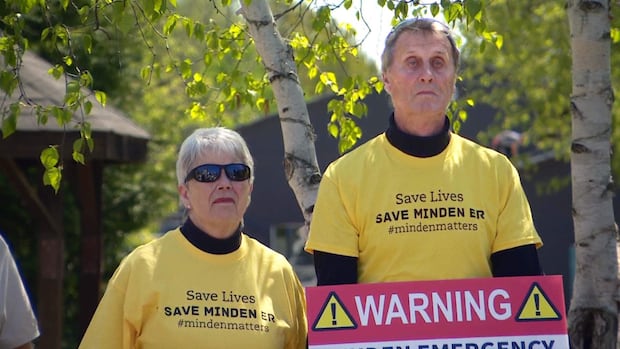
This story is part of CBC Health’s Second Opinion, a weekly analysis of health and medical science news emailed to subscribers on Saturday mornings. If you haven’t subscribed yet, you can do that by clicking here.
Wendy Guimont’s tumour didn’t kill her. But a cascade of errors tipped the scales.
The beloved piano teacher inspired and trained music instructors for children across Canada. A go-getter who loved to hike, bike and golf, the Cranbrook, B.C., resident and her husband jumped at the chance to drive an RV to Arizona.
While in the U.S., back pain Guimont had initially brushed off worsened. On Valentine’s Day in 2021, she learned she had metastatic pancreatic cancer. Remarkably, her family says, she gained weight and strength while on chemotherapy. Then, on July 8, 2023, she died — not of cancer, but of kidney failure following a severe drug reaction to the antibiotic vancomycin.
“It’s just sad because I feel like she could have fought a lot longer and who knows, with my mom, if we didn’t have kidney failure to deal with on top of cancer,” said daughter Penny Guimont of Grafton, Ont., about 120 kiometres east of Toronto.
Vancomycin is an antibiotic commonly prescribed to treat infections such as staph. It comes with risks, particularly when the treatment lasts more than a week and in certain patients, such as those aged 65 (such as Wendy), or older. That’s why doctors developed guidelines saying vancomycin levels, when delivered intravenously, need to be carefully monitored and timed to determine whether the dose needs to be adjusted, drug safety experts say.
But staffing and other challenges in hospitals mean important steps can be missed or delayed, leading to severe kidney injury, or as in Guimont’s case, death.
Continuous vancomycin can injure the kidneys, and about 10 per cent of patients given standard doses of the drug develop vancomycin-induced kidney damage — also known as nephrotoxicity. Those critically ill in ICU show the highest rates.

About 12 months after Wendy started aggressive chemotherapy, imaging showed the tumour had shrunk. But the tumour also caused a blockage in her bile duct, which required a stent. When this became blocked, it caused an infection in her blood, and she was prescribed vancomycin.
Measuring drug’s troughs, not peaks
The infection developed into sepsis, Penny said. The life-threatening condition results from the immune system’s overreaction to fighting an infection. Wendy recovered.
“My mom was stable and she was out of ICU,” Penny recalled. “She was deemed to be able to transfer back to Cranbrook, and I think this is where things started to fall apart.”
Wendy was transferred back to East Kootenay Regional Hospital in Cranbrook on Feb. 25, 2023, and Penny joined her the next day. Wendy remained on IV vancomycin.
Hospital staff drew a sample to identify what’s called a key trough level, meaning the lowest concentration of vancomycin sinks to before the next dose.
The sample was taken just hours after a dose of vancomycin was given, “making it a peak level and impossible to draw conclusions,” according to Interior Health, the health authority for the Cranbrook hospital.
A letter Penny received from Interior Health’s Patient Care Quality Office and shared with CBC News goes on to say the Cranbrook hospital pharmacist was aware of the issue, wrote a note and reviewed findings the next day when a new trough level was measured.
The hospital noted Wendy’s kidney function worsened on March 1, a marker of kidney failure, which led to “appropriate holding” of vancomycin and a diuretic medication.

By then, the vancomycin level was 42 mg/L. That’s triple the desired level, says Penny, who is a hospital pharmacist herself and treats kidney patients. B.C.’s guidelines recommend targeting trough concentrations of 10 to 15 mg/L, which U.S. researchers also suggest for antimicrobial effectiveness and to avoid toxicity for the majority of patients.
“When they did check Mom’s kidney function later that day, it had gotten acutely worse,” she said.
“So it was incredibly clear to me what was happening, incredibly, and I was upset that I couldn’t have intervened sooner.”
The hospital’s letter said a trough level was ordered within three days of arrival, “unfortunately it was not collected properly. The chief of staff would like to provide assurance that they plan to investigate further to understand how this error occurred and to implement necessary learnings and education to prevent future occurrences.”
In a statement to CBC News, Interior Health said it is sorry for the family’s loss.
“Due to requirements to protect patient privacy, we cannot make public comments about individual cases or medical information, but our Patient Care Quality Office has shared information directly with the family.”
Interior Health added if patients or families are not satisfied, they can request an independent review from B.C.’s Patient Care Quality Review Board.
Penny said she asked for a formal medical review of her mother’s chart because she doesn’t want such an incident to ever happen again. Currently, she has not asked for an independent review. The province’s Patient Care Quality Review Board includes lawyers, physicians and laypeople.
“Once this kidney failure kicked in, she couldn’t eat. She had nausea, she felt so crummy and it really robbed us of all hope from there on in.”
Tailspin to kidney failure
British Columbia’s 2022 guidelines on dosing intravenous vancomycin, as well as national safety bulletins on its use, highlight how and when hospital staff should monitor concentrations of the drug to keep patients safe.
Blood levels of vancomycin must be kept within a narrow range that’s high enough to fight the infection but below levels that could lead to organ damage and other harms.
The community of Minden, Ont. is fighting to keep its only emergency room open. Haliburton Highlands Health Services announced in April that it would close the ER due to what it says are medical staffing shortages — a problem echoed across Canada.
Researchers think that acute kidney damage injury is caused by vancomycin stopping blood flow and oxygen from reaching the kidneys.
Katharina Kovacs Burns, chair of the board for Patients for Patient Safety Canada, said the case highlights how important it is for health workers to understand and follow dosing and monitoring procedures, such as checks of vital signs and side-effects.
Since each patient reacts to medications differently depending on their circumstances, communicating drug information to the patient and families can also help them spot if something seems awry.
“Vancomycin put [Wendy] into a tailspin into kidney failure, basically, which is bad news because once your system starts shutting down, you can’t respond appropriately,” Kovacs Burns said.
The patient safety advocate said double-check procedures are in place for a reason.
“I do believe that they try their utmost to follow it, but there’s always the odd circumstance, and some would say it’s due to staff shortage,” Kovacs Burns said.
“Well, that shouldn’t be the case. If somebody’s being administered a drug or a medication, any treatment, then you know there needs to be that follow up.”
Patients for Patient Safety Canada also recommends patients ask questions about what medications are being administered and for what reason.
In the letter from the Patient Care Quality Office, Wendy’s case is called “a very unfortunate drug reaction.” The hospital’s chief of staff does not believe it was due to lack of staffing or inappropriate ordering.
Patients prescribed vancomycin “should have a formal order written to involve pharmacy to guide dosing intervals,” according to the letter. It also says the hospital plans to address this with physicians, “as an action resulting from this complaint.”
Seeking transparency
Penny, despite her professional role as a hospital pharmacist, said she had been focused on comforting and supporting her mom — not monitoring her drugs.
While she welcomes the hospital’s new decision to have pharmacists review vancomycin orders, she believes if a pharmacist was on call over the weekend, it could’ve helped when her mom was transferred.
She’s also seeking more transparency about the circumstances leading to the errors.
In an email, the family said while mistakes were made, some health-care providers “completely shined. They went above and beyond not only for mom, but for all of us.”
Wendy’s obituary thanks the hospital’s oncology team as well as home care nurses.
In retrospect, and wearing her pharmacist hat, Penny believes a lower dose of vancomycin may have sufficed for Wendy, who did not have an antibiotic-resistant infection.
In her job, Penny regularly sees patients bounce back from nephrotoxicity once the vancomycin is stopped, a recovery that the medical literature also indicates often happens.
“There’s so many inefficiencies in health care and I think errors give an opportunity to make proper change.”
